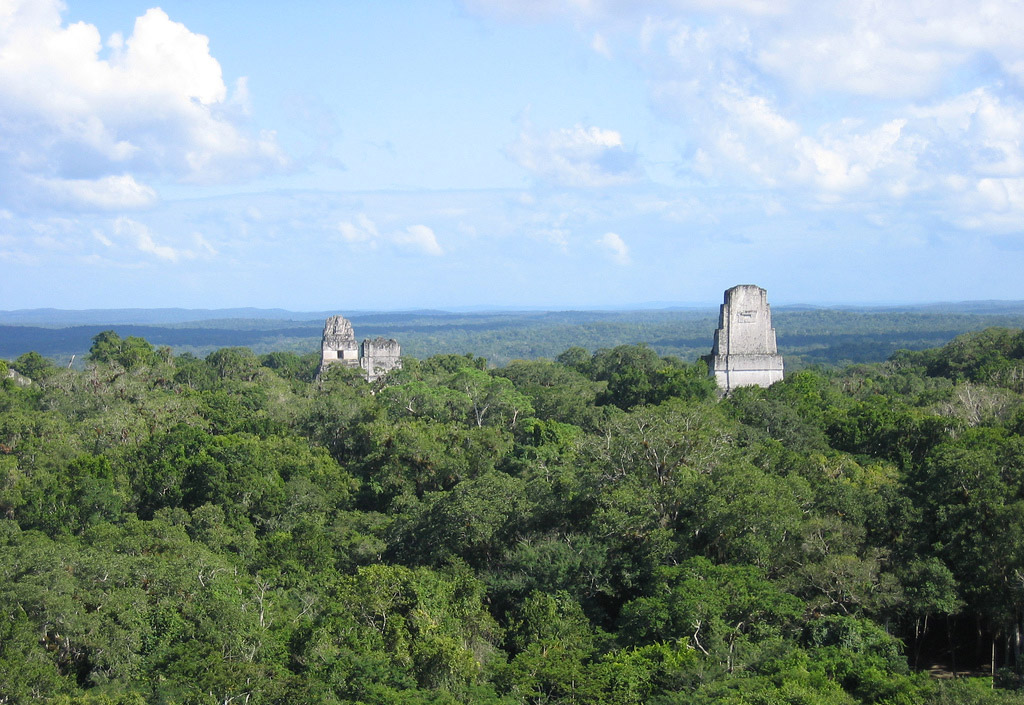
Ruins of Tikal visible above the treetops. Photo © Victoria Reay, licensed Creative Commons Attribution.
This stretch of coastline, islands, and swampy lowlands includes former capital Belize City, still the hub of Belizean city life and the heart of its colonial past. A few historic sights and events, such as Carnival, make it worth a quick visit, even for a day. Whether or not you appreciate the city’s unique grit and Caribbean texture, don’t miss nearby attractions like The Belize Zoo, The Community Baboon Sanctuary and surrounding Creole villages, Crooked Tree Wildlife Sanctuary, and Altun Ha.
This group of islands is the most visited part of Belize. Ambergris Caye lures with swanky beach resorts, endless bars, and plentiful restaurants. Caye Caulker, just down the reef, offers a less dizzying pace with an authentic, Caribbean vibe and opportunities for snorkeling at The Split or viewing manatees at Swallow Caye Wildlife Sanctuary. The northern atolls of Turneffe Islands and Lighthouse Reef Atoll offer spectacular wall diving, beautiful beaches and bird life, and Jacques Cousteau’s old favorite, the great Blue Hole.
Once the heart of the Mayan civilization, Belize’s western interior offers a remarkable selection of outdoor activities. Explore the Mayan archaeological sites of Xunantunich, near San Ignacio, or Caracol, further south. Wander the Belize Botanic Gardens, spelunk through Actun Tunichil Muknal—one of the world’s most amazing caves—or overnight in a jungle lodge on the Macal River or in the Mountain Pine Ridge. While the capital of Belmopan can be largely skipped, don’t miss the surrounding countryside along the beautiful Hummingbird Highway, snaking south through the district to some of the most beautiful parks, including St. Herman’s Blue Hole National Park.
Dangriga is the center of Belize’s Garífuna population, with an Afro-Caribbean beat, cultural and outdoor activities, and a strategic location close to Billy Barquedier National Park. Just down the coast, lazy Hopkins has long stretches of beach, and plenty of dining and accommodation options, as well as a strong Garífuna vibe. Further south, the Placencia Peninsula, is the home of “barefoot perfect,” 16-mile beaches and the low-key but touristy village of Placencia. The surrounding Stann Creek District offers some of the best hiking in Belize, including Mayflower Bocawina National Park in the Maya Mountains, and the world’s only jaguar preserve at Cockscomb Basin Sanctuary. Off the coast of Dangriga, the southern cayes of Tobacco Caye and Glover’s Reef Atoll offer spectacular diving and snorkeling, while Laughingbird Caye National Park, off the coast near Placencia, is a World Heritage Site.
Forest and reef, river and ruins, caves and ridges—all await the small handful of visitors who get off the beaten path into the “deep south” of Belize. Whether you follow the cacao trail through Punta Gorda or take a private drumming lesson at one of the Garífuna drum schools, don’t miss the opportunity to sign up with a homestay program in the Maya villages, where you can immerse yourself in everyday life. The archaeological site of Lubaantun begs exploring, as do the beautiful waterfalls at Río Blanco National Park and Blue Creek Cave. Further off the coast, Sapodilla Cayes offers top-notch snorkeling and diving.
Northern Belize is often skipped by travelers—unless they’ve heard about Chan Chich Lodge, a unique rainforest eco-lodge at the Gallon Jug Estate, or the gorgeous accommodations at Lamanai Outpost Lodge, set amid the remote, vast Maya ruins of Lamanai Archaeological Site. Both are set deep in the bush and are as popular with birders and naturalists as they are with archaeologists and biologists. Aside from these draws are the hubs of Orange Walk Town and Corozal. Corozal is a great launching pad to nearby picturesque Sarteneja, home of Belize’s traditional wooden sailboat building.
High season is mid-December through May, a period many travel agents will tell you is the “dry season,” in a vain effort to neatly contain Belize’s weather patterns. In many years this is true, with sunny skies and green vegetation throughout the country during the North American winter. However, November can be dry and sunny, while December, January, and even February can play host to wet cold fronts that either blow right through or sit around for days. The weather has become more unpredictable each year, like most places in the world.
June, July, and August technically form the rainy season—which may mean just a quick afternoon shower or rain for days. This also means significantly discounted accommodations. August is most popular with European backpackers, while December and February are dominated by North Americans. Some tourism businesses shut down completely during the month of September and part of October, the peak of hurricane season.
Your best bet? Be prepared for clouds or sun at any time of year. A week of stormy weather may ruin a vacation planned solely around snorkeling, but it could also provide the perfect setting for exploring the rainforests or enjoying a hot tub and fireplace in the Mountain Pine Ridge.
Excerpted from the Tenth Edition of Moon Belize.